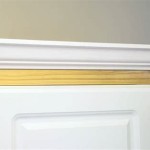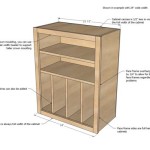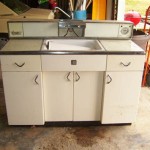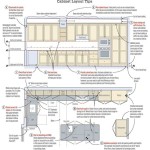The Most Efficient Way to Organize Kitchen Cabinets
Kitchen cabinets, often the unsung heroes of culinary spaces, can quickly transform into chaotic storage zones. A disorganized kitchen can lead to wasted food, difficulty locating essential cooking tools, and an overall sense of frustration. Implementing a strategic organizational system can streamline meal preparation, improve kitchen functionality, and create a more enjoyable cooking experience. This article explores proven techniques for achieving efficient kitchen cabinet organization, focusing on maximizing space, prioritizing accessibility, and maintaining order over time.
Assessing Current Cabinet Space and Needs
The first step towards efficient cabinet organization involves a comprehensive assessment of the existing space and the items requiring storage. This initial evaluation provides a clear understanding of the current situation, highlighting areas for improvement and informing subsequent organizational decisions. Begin by emptying each cabinet completely. This allows for a thorough cleaning and facilitates an objective assessment of the available space. As items are removed, categorize them based on type, such as cookware, bakeware, food storage containers, spices, and dry goods.
During the categorization process, critically evaluate each item. Consider its frequency of use, its condition, and its necessity. Items that are rarely used, damaged, or duplicated should be considered for donation or disposal. This decluttering stage is crucial for maximizing available space and preventing unnecessary accumulation of items. After decluttering, measure the interior dimensions of each cabinet, including height, width, and depth. This information will be essential when selecting organizational tools and optimizing storage configurations. Finally, analyze individual cooking habits and preferences. Identify frequently used items and designate accessible storage locations for them. Infrequently used items can be relegated to less accessible areas.
Implementing Strategic Storage Solutions
Once the assessment is complete, the next phase involves implementing strategic storage solutions that maximize space and accessibility. Several organizational tools and techniques can be employed to achieve this goal. Shelf organizers, such as wire shelves and risers, can effectively double the vertical space within cabinets. These organizers are particularly useful for storing plates, bowls, and canned goods, allowing for easy visibility and access. Drawer dividers are essential for organizing utensils, cutlery, and kitchen gadgets. These dividers prevent items from shifting and becoming jumbled, ensuring that everything is easily accessible and neatly arranged.
Another effective solution is the use of lazy Susans, especially in corner cabinets. These rotating platforms allow for easy access to items that would otherwise be difficult to reach. Lazy Susans are ideal for storing spices, condiments, and baking ingredients. Food storage container lids often contribute to cabinet clutter. A dedicated lid organizer can keep lids neatly stacked and readily accessible, eliminating the frustration of searching for matching lids. Clear, stackable containers are recommended for storing dry goods such as flour, sugar, and pasta. These containers not only keep food fresh but also provide a visually appealing and organized storage system. Labeling each container with its contents and expiration date further enhances organization and prevents food waste.
Consider installing pull-out shelves, particularly in lower cabinets. These shelves glide out smoothly, providing easy access to pots, pans, and other heavy items. Pull-out shelves eliminate the need to bend and reach into the back of cabinets, making them an ergonomic and efficient storage solution. For storing spices, consider using a spice rack or a spice drawer organizer. These organizers keep spices visible and readily accessible, making it easy to locate the desired spice during cooking. Additionally, pot racks can be installed above the stove or on a nearby wall to free up cabinet space. Pot racks provide convenient storage for frequently used pots and pans, keeping them within easy reach.
Maintaining Order and Preventing Future Clutter
Achieving efficient cabinet organization is not a one-time task; it requires ongoing maintenance and proactive measures to prevent future clutter. Establish a regular cleaning schedule for kitchen cabinets. This involves wiping down shelves and drawers periodically to remove crumbs, spills, and dust. Regular cleaning not only keeps cabinets tidy but also prevents the buildup of grime and food residue, which can attract pests. Implement a "one in, one out" rule for new kitchen items. Before purchasing a new gadget or appliance, consider whether it is truly necessary and whether it will replace an existing item. This prevents the accumulation of unnecessary items and helps maintain a clutter-free kitchen.
Consistently evaluate the contents of kitchen cabinets and declutter as needed. This ongoing assessment ensures that items are not accumulating unnecessarily and that the organizational system remains effective. Regularly review expiration dates on food items and discard any that have expired. This prevents food waste and maintains a fresh and organized pantry. Encourage all members of the household to participate in maintaining kitchen organization. This includes putting items back in their designated locations after use and following the established organizational system. With everyone's cooperation, maintaining order becomes a shared responsibility.
Periodically reassess the organizational system and make adjustments as needed. Kitchen needs and cooking habits may change over time, requiring modifications to the storage configuration. Be flexible and willing to adapt the organizational system to ensure that it continues to meet evolving needs. Consider taking photographs of the organized cabinets before and after making changes. These photos can serve as a visual reference and provide inspiration for future organizational projects. Finally, invest in high-quality organizational tools that are durable and easy to maintain. While inexpensive tools may seem appealing initially, they may not withstand the wear and tear of daily use. Investing in quality tools can ensure that the organizational system remains effective and visually appealing for years to come.
:max_bytes(150000):strip_icc()/crop-silvery-blue-cabinets-2000-70acba9f5faf464aa377714297d92570-a9692c7ba11e44ac86bc8f41c0a9fb42.jpg?strip=all)
How To Organize Your Kitchen Cabinets According Experts

60 Clever Cabinet Organization Tips To Double Your Storage 2024
:strip_icc()/121035540_331772381251072_3717720175166945340_n-ae336a3237ca44c6bdddd093c7d1eb97.jpg?strip=all)
21 Kitchen Cabinet Organization Ideas You Need To Try

How To Organize Your Kitchen Cabinets And Pantry Feed Me Phoebe

Best Way To Organize Kitchen Cabinets Step By Project The Container

60 Clever Cabinet Organization Tips To Double Your Storage 2024

How To Organize The Inside Of Your Kitchen Cabinets

How To Organize Your Kitchen Cabinets And Pantry Feed Me Phoebe

25 Best Ideas For How To Organize Kitchen Cabinets

Best Way To Organize Kitchen Cabinets Step By Project The Container
Related Posts








